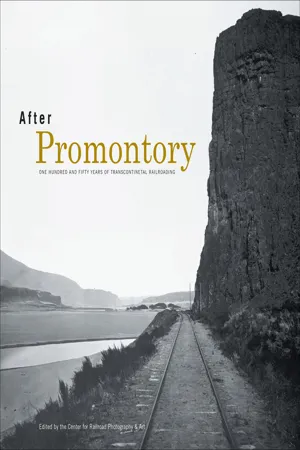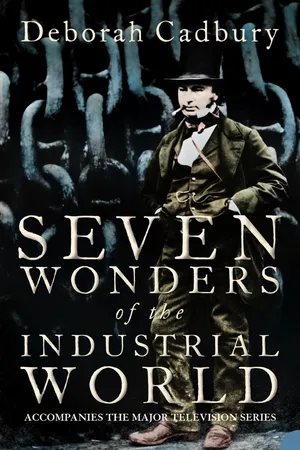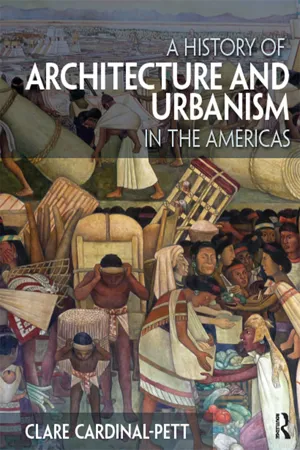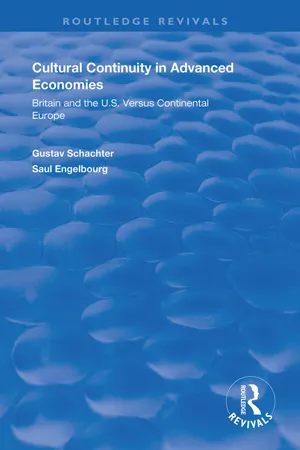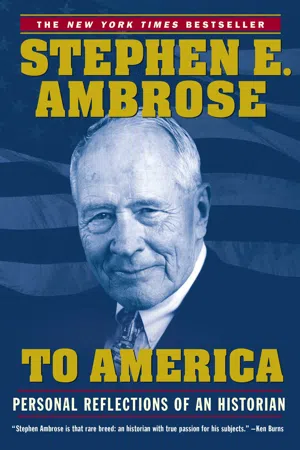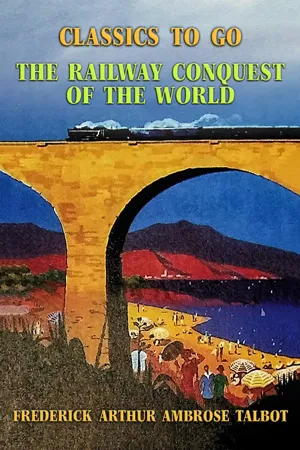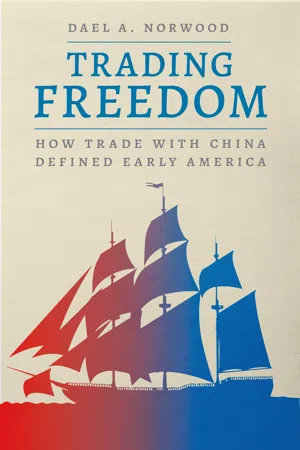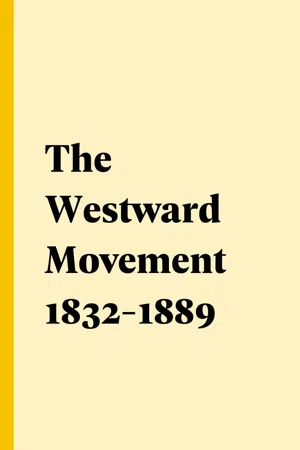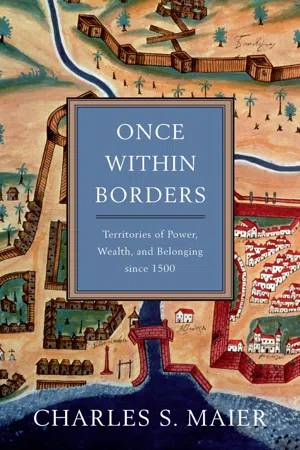History
Transcontinental Railroad
The Transcontinental Railroad was a railway system built in the United States during the 19th century, connecting the east and west coasts. Completed in 1869, it revolutionized transportation and commerce by significantly reducing travel time and costs for both passengers and freight. The construction of the railroad also played a significant role in the westward expansion of the United States.
Written by Perlego with AI-assistance
Related key terms
Related key terms
1 of 4
Related key terms
1 of 3
10 Key excerpts on "Transcontinental Railroad"
- eBook - ePub
After Promontory
One Hundred and Fifty Years of Transcontinental Railroading
- Keith L. Bryant, Drake Hokanson, Don L. Hofsommer, Maury Klein, The Center for Railroad Photography & Art, Peter A. Hansen, The Center for Railroad Photography & Art, Peter A. Hansen(Authors)
- 2019(Publication Date)
- Indiana University Press(Publisher)
The Southern TranscontinentalsThe Southern Transcontinental Keith L. Bryant Jr.{ Keith L. Bryant Jr. }I n 1872 German-born artist John Gast painted an iconographic work he titled American Progress. A large central figure, a young woman he called Progress, wears a diaphanous white gown as she strides westward, carrying a telegraph wire in her left hand and a coil of wire and a book in her right. She advances Western civilization even as Native Americans and a buffalo herd flee to the west. Miners and farmers move forward, as do a Conestoga wagon and a stagecoach. In the foreground a passenger train crosses the prairie, and in the background a freight train leaves a port city. Chromolithographic prints of this allegorical painting soon graced the walls of homes, businesses, and public buildings. The popular work vividly depicted the concepts of Manifest Destiny and American exceptionalism that were central to the national character.The presence of the trains is but one example of how the American people visualized the conquest of the West, which the railroads could accomplish. In the 1840s and 1850s dozens of railroad conventions and meetings across the nation east of the Mississippi River demanded the creation of transcontinental carriers. Political leaders echoed these sentiments. Senator Stephen A. Douglas of Illinois was determined that Chicago would be the eastern terminus of such a railroad, while Senator Thomas Hart Benton of Missouri envisioned St. Louis as the starting point. Mississippi Senator Jefferson Davis spoke for the South when he urged that New Orleans or Memphis, Tennessee, be named as the starting point for the railroad. Throughout the 1850s debates over the routes to the Pacific rang out in Washington and in the national press. The eyes of the country focused on the creation of giant railroads, a reality that the public greatly romanticized. - Deborah Cadbury(Author)
- 2012(Publication Date)
- Harper Perennial(Publisher)
5 The Transcontinental Railroad ‘It will be the work of giants … and Uncle Sam is the only giant I know who can grapple the subject.’ William Tecumseh Sherman, 1857 I N THE EARLY PART of the nineteenth century, the vast continent of North America lay as it had for centuries, marked only by Indian and buffalo trails and the worn wagon tracks of those making the journey west. Travel across the Great Plains, wide rivers, deserts and mountain ranges was slow and dangerous, with no guarantee of safe arrival in California. Many making the journey from east to west preferred to travel by sea, braving a six-month voyage around South America’s Cape Horn, rather than attempt the hazardous overland crossing. The only other route was to cross the Isthmus of Panama and board a ship to San Francisco – risking yellow fever, malaria and other deadly diseases. Thousands never reached their destination; their bleached bones scattered across the Great American Desert or washed up on the shores of South America. At first, the railroad was not an obvious solution to these transport difficulties. In 1830, when the first American-built locomotive, Tom Thumb, was set to compete with a horse-drawn wagon racing next to the track, its boiler burst. But from modest beginnings there followed an unprecedented boom in the railroad industry. During the 1830s and 1840s many railroads sprang up in the eastern states, casting a filigree pattern of transport across the landscape and linking the east coast cities. By 1850, there were over 9,000 miles of track and this continued to be laid at a rate of over 2,000 miles a year, reaching inland to towns on the Missouri River- Clare Cardinal-Pett(Author)
- 2015(Publication Date)
- Routledge(Publisher)
Figure 7.5 ).7.4 US President Abraham Lincoln’s Pullman executive car/funeral car7.5 The original Banff Springs Hotel photographed in 1902In spite of all the hurdles, the incremental implementation of transportation networks capable of supporting steamships and locomotives had remapped many parts of the Americas by the end of the 19th Century. Places without infrastructure struggled to keep pace economically. Particularly disadvantaged were the emerging nations of the Andean region where the rugged landscape resisted railroads. Mineral resources such as nitrates (for fertilizer and gunpowder) encouraged railroad investment nevertheless. Against all odds, engineers blasted tunnels through mountains, threw bridges over gorges and negotiated steep grades with long switchbacks. The Peruvian Central Railway climbs out of the port of Callao just north of Lima, reaching an altitude of 15,604 feet in just 172 miles of track (Figure 7.6 ). Construction of the line began in 1870 under the supervision of an entrepreneur from Catskill, New York, Henry Meiggs, who planned to take the railroad all the way to a port on the Amazon, effecting his own transatlantic shipping route.4 Meiggs, who built ships, warehouses, and wharves (including Fisherman’s Wharf) in San Francisco during the gold rush, left the USA for South America to avoid a conviction for fraud. His Peruvian Central Railroad (one of several projects in Chile and Peru he initiated) imported rails from England, rail cars from the USA, and redwood for railroad ties from California. When Meiggs died, in Lima in 1877, he was working with his nephew, Minor Cooper Keith, on a railroad project for Costa Rica to facilitate coffee exports from the port at Limon. Keith took over the project, which opened for business in 1890.5- eBook - ePub
Cultural Continuity in Advanced Economies
Britain and the U.S. Versus Continental Europe
- Gustav Schachter(Author)
- 2019(Publication Date)
- Routledge(Publisher)
Chapter 4The Railroads and the State During the Nineteenth Century
The coming of the railroad represents the transcendent economic event of the nineteenth century.1 With vital backward and forward linkages and thus a widely diffused impact on industrialization as well as a huge initial capital investment, the railroad proved to be by far the most important innovation of the century.2 All this held true for Britain but with a unique twist; as the first industrial nation, the Railroad Age arrived in Britain after the first phase of industrialization and capital accumulation had been completed. Perhaps for this reason, the State, hardly absent (nor could it be), played a distinctive but a lesser role in railroad growth and development, they were regulated early and often.While the Anglo-Americans and the Continentals have had different approaches to building, operating, financing, and regulating railroads, there were critical differences between Britain and the United States. Britain was the world’s exporter of both manufactured goods and capital while the United States imported both manufactured goods and capital. Britain had ample domestic capital readily available, enough so that it exported capital, while the United States depended substantially on foreign investors for constructing railroads. British railroads connected existing cities, that is, essentially Britain did not build exploitative railroad whereas the United States built both exploitative and developmental railroads. This is why in the United States, especially before the Civil War, railway entrepreneurs relied on State aid such as financing and grants of unoccupied public land.During the first decade or two of the railroad era, most people underestimated the economic potential of the railroad. Like most innovations, the railroad underwent critical improvements, which had profound economic impact. Locomotives became more and more powerful and switched from wood to coal and, by the end of the century, to electric power. By 1880 steel replaced iron rails, increasing traction and durability. All these innovations incurred a tremendous sunken cost that investors and/or the State had to bear. The choices were not that clear, and all countries toyed with private, public, and a mix of private and public scenarios. - eBook - ePub
To America
Personal Reflections of an Historian
- Stephen E. Ambrose(Author)
- 2002(Publication Date)
- Simon & Schuster(Publisher)
Chapter Four
The Transcontinental Railroad
B y 1866–67 nothing was going to stop the Transcontinental Railroad. But until 1862, the unanswered questions were who would build it, when, how, and what it would cost. It was a stupendous project, the biggest engineering challenge ever undertaken. To invest money and time in the railroad would be risky beyond anything ever before attempted, but when and if it were completed it would link the continent, changing forever the nation’s politics and economics and bringing great profits to the men who built and owned it.Even by 1850 the Transcontinental Railroad was something everyone in America wanted built, and the technology was ready to do it. But the cost would be heart-stopping and only the federal government had the resources—including all the land it owned—to finance the project. The Southerners in Congress wanted it to run from New Orleans through Texas to southern California, thus increasing the slave states’ economy and political clout. The Northerners wanted it to run from Chicago to Sacramento and San Francisco, or from Minneapolis to Portland, increasing the free states’ economy. The two sides blocked each other throughout the decade of the 1850s.In the 1860 campaign, Abraham Lincoln and the Republican Party pledged to get the construction going immediately. When Lincoln won the election, the South did the most stupid of all the stupid things it had done until then—it seceded from the Union, and its senators and representatives walked out of the Congress. That opened the way for the railroad, over the northern route, through the Great Plains, over the Rocky Mountains, through the Great Basin, over and through the Sierra Nevada.With the nation at war from 1861 to 1865, it seemed impossible. Nevertheless, one of the first things Lincoln and the Republican Party did after secession was to propose a bill authorizing and providing loans and land grants for the construction of a line from Omaha to Sacramento. There are many reasons why the South lagged so far behind the North in the century after the Civil War, and losing the war was certainly at the top of the list, but right behind came walking out of Congress and allowing the North to have the Transcontinental Railroad. - eBook - ePub
- Frederick Arthur Ambrose Talbot(Author)
- 2022(Publication Date)
- Otbebookpublishing(Publisher)
Development is still being maintained; new territories are being conquered. A new long and sinuous arm, 3,556 miles from end to end, is being stretched out from the Atlantic to the Pacific Ocean, to bring the eastern into direct touch with the western seaboard. The whole has grown from the insignificant little wooden road that was laid between La Prairie and St. John’s in the Province of Quebec eighty years ago.Passage contains an image
CHAPTER V THE FIRST TRANS-CONTINENTAL ACROSS THE UNITED STATES
“There were difficulties from end to end: from high and steep mountains; from snows; from deserts where there was a scarcity of water, and from gorges and flats where there was an excess; difficulties from cold and heat; from a scarcity of timber and from obstructions of rock; difficulties in keeping a large force on a long line; from Indians; and from want of labour.”This was the terse story related to the United States Congress by Collis P. Huntington, one of the moving spirits of what, at that time, was a tremendous undertaking—the construction of the first railway across North America whereby the Atlantic was linked with the Pacific by a bond of steel. But that concise statement concealed one of the most romantic stories in the history of railway engineering: of grim battles every hour either against the hostile forces of nature or of mankind.It was in 1863 that the first sod was turned in the construction of the first line which was destined to bring San Francisco within 120 hours’ journey of New York, and which changed completely the whole stream of traffic flowing round one-half of the northern hemisphere. But for some years before the spade was driven into the earth to signal the commencement of this enterprise, the idea had been contemplated and discussed in a more or less academic manner. It was such a vast scheme, the commercial possibilities of success appeared so slender that the most daring financiers of that day shrank from fathering it. Capitalists concluded that they might just as well pour their money down a well as to sink it in such a project as this. - eBook - ePub
American Beginnings, 1500-1900
How Trade with China Defined Early America
- Dael A. Norwood(Author)
- 2022(Publication Date)
- University of Chicago Press(Publisher)
After his memorial to Congress in 1845, “proposing Pacific railroads became an industry.” 37 Transcontinental plans proliferated, hawked by opportunistic politicians, ambitious boosters, and sharp-dealing land speculators across the country. They diverged on many matters, from the funding structure to the estimated pace of construction, and, most critically, on routes and endpoints. But what remained constant during this infighting is revealing. All the plans on offer agreed on the road’s motivation: to capture Asia’s trade for the United States. George Wilkes, a self-proclaimed Oregon expert and rival railroad promoter, only stated the now-conventional wisdom when he noted that “the commerce of the East, in every age, has been the source of the opulence and power of every nation which has engrossed it.” 38 This perspective was so commonplace after the publication of Whitney’s plan that it hurt his claim to distinctiveness. Professional proslavery advocate and editor J. D. B. De Bow argued that “the world having dreamed so long of reaching the Indies by reduced travel,” it would be pointless to try to determine the true originator of the idea of a Transcontinental Railroad scheme. “Such is the progressive nature of American mind,” he opined, that “we may argue that this idea of a passage across the continent must have occurred to many simultaneously with the first successful railroad results among us.” 39 De Bow’s belittlement raises an interesting question: Why, in the late 1840s, did the idea of access to “the Indies” gain such a hold on the American imagination, even when separated from the clever constitutional politics of Whitney’s plan? The opportunities Whitney profited from while he was a merchant in China are part of the answer - eBook - ePub
- Elizabeth B. Greene(Author)
- 2022(Publication Date)
- Greenwood(Publisher)
Manifest Destiny, the widespread belief during the 19th century that the expansion of the United States from “sea to shining sea” was not only justified but also inevitable, was coined in 1845 by influential journalist John L. O’Sullivan while advocating for the annexation of Oregon and Texas. The relief valve that the opening of the West represented lured thousands of eager settlers to pack up their prairie schooner wagons and make the treacherous journey on wagon trains that lumbered along the Oregon or Santa Fe Trail. The perilous trip took six months and had to be started in the spring, so it could be completed before the onset of the winter. Such risk didn’t deter these hardy souls from venturing out, but the situation would soon be transformed when the Transcontinental Railroad opened in 1869. Railroad lines had already been built along the East Coast beginning in the 1830s, and the South and Midwest were connected by networks of railroads by the 1840s. California was annexed in 1848 after the Mexican-American War, the same year that gold was discovered there. The region soon became a magnet for fortune-seekers and settlers. In 1850, California joined the union as the 31st state. Congress began investigating the possibility of building a railroad to California. In 1853, Congress appropriated funding for the Army Topographic Corps “to ascertain the most practicable and economical route for a railroad from the Mississippi River to the Pacific Ocean.” Surveyors were sent out to investigate four separate routes, and debates took place regarding the advantages of a northern or southern route. No matter which route they opted for, any Transcontinental Railroad would require risky and dangerous construction over an intimidating landscape of mountains and deserts. The task was daunting, but despite the Civil War that was raging, President Abraham Lincoln advocated for the railroad to be built, and on July 1, 1862, he signed the Pacific Railway Act. This legislation authorized land grants and government bonds to two companies, the Central Pacific Railroad and the Union Pacific Railroad, to lay the track for the country’s first Transcontinental Railroad, with the Central Pacific Railroad coming from the west and the Union Pacific Railroad coming from the east. They would meet at the middle.Description
This 1869 official poster announced the grand opening of the first Transcontinental Railroad. The ceremony took place on May 10, 1869, at Promontory Summit near Ogden, Utah. The poster, printed by the Union Pacific Railroad, was more of an advertisement for the rail service than an invitation to the ceremony. The text of the poster, loaded with rapturous promotion of the service and the ceremony, states the following: - eBook - ePub
- (Author)
- 2019(Publication Date)
- Perlego(Publisher)
To Walt Whitman this event had a highly emotional significance. It came in the same year that the Suez Canal was opened, and to Whitman the two events marked a great step forward in the advance of civilization. In his poem, “A Passage to India,” Whitman writes of the continental railroad:I see over my own continent the Pacific railroad surmounting every barrier, I see continual trains of cars winding along the Platte carrying freight and passengers, I hear the locomotives rushing and roaring, and the shrill steam-whistle, I hear the echoes reverberate through the grandest scenery in the world, I cross the Laramie plains, I note the rocks in grotesque shapes, the buttes, I see the plentiful larkspur and wild onions, the barren, colorless, sage-deserts, I see in glimpses afar or towering immediately above me the great mountains, I see the Wind river and the Wahsatch mountains, I see the Monument mountain and the Eagle’s Nest, I pass the Promontory, I ascend the Nevadas, I scan the noble Elk mountain and wind around its base, I see the Humboldt range, I thread the valley and cross the river, I see the clear waters of lake Tahoe, I see forests of majestic pines, Or crossing the great desert, the alkaline plains, I behold enchanting mirages of waters and meadows, Marking through these and after all, in duplicate slender lines, Bridging the three or four thousand miles of land travel, Tying the Eastern to the Western sea, The road between Europe and Asia.Samuel Bowles Travels on the Union Pacific
During the summer before the railroad was finished, the editor of the Springfield, Massachusetts, Republican, Samuel Bowles, visited the West. He traveled over the Union Pacific from Omaha, which he noted had become a boom town since he had visited it last in 1865. He describes his ride along the same route followed by the Oregon Trail and the Overland Stage.The day’s ride grows monotonous. The road is as straight as an arrow. Every dozen or fifteen miles is a station—two or three sheds, and a waterspout and wood-pile; every one hundred miles or so a home or a division depot, with shops, eating-house, “saloons” uncounted, a store or two, a few cultivated acres, and the invariable half-a-dozen seedy, staring loafers, that are a sort of fungi indigenous to American railways. We yawn over the unchanging landscape and the unvarying model of the stations, and lounge and read by day, and go to bed early at night. But the clear, dry air charms; the half dozen soldiers hurriedly marshalled into line at each station, as the train comes up, suggest that the Indian question is not disposed of yet; we catch a glimpse of antelopes in the distance; and we watch the holes of the prairie dogs for their piquant little owners and their traditional companions of owls and snakes—but never see the snakes. - eBook - ePub
Once Within Borders
Territories of Power, Wealth, and Belonging since 1500
- Charles S. Maier(Author)
- 2016(Publication Date)
- Belknap Press(Publisher)
But in the absence of any willingness to make railroad construction a state enterprise, the logic seemed compelling. Transcontinental Railroads transformed unsettled territory into a real national asset. Since it required capital to build these lines, why not privatize, say, 5 percent of the territory to be transformed to achieve the development of it all? 48 There are rarely unambiguous answers to the question, Cui bono? As with earlier projects that addressed the promise of appropriating wealth from land, the key to reaping a return was to have the territory that the railways served attract a stable workforce. Railroad lines might serve to link mines and agricultural depots with distant markets, but settlers would also be needed. For Matthew Maury in the pre–Civil War South, that meant expanding a slave labor force; for the northern states and the Canadians, it meant giving free farmers inexpensive land. The massive tracts that Canadians and U.S. legislatures awarded to the rail companies should be viewed alongside the Homestead Act of 1862, which culminated a long-held aspiration of the new Republican Party. Any adult who had not taken up arms against the United States could gain title for 160 acres (one quarter of a square mile) at $1.25 acres per acre provided he improved the land and continued in residence for five years. The railroads also involved importing labor as well as settling farmers—immigrants to the United States eventually from southern and eastern Europe and from China and Japan, to add to those from Ireland and Germany (and of course Africa) earlier. Secretary of State William H. Seward signed the Burlingame Treaty of 1868 to admit Chinese coolie labor for work on the Pacific railway and the western mines and celebrated America’s expansion toward Asia. In South America, European migrants toiled on the construction projects. The railroads knit together countries by virtue of their needs for labor as well as the transportation they later provided
Index pages curate the most relevant extracts from our library of academic textbooks. They’ve been created using an in-house natural language model (NLM), each adding context and meaning to key research topics.
Explore more topic indexes
Explore more topic indexes
1 of 6
Explore more topic indexes
1 of 4
